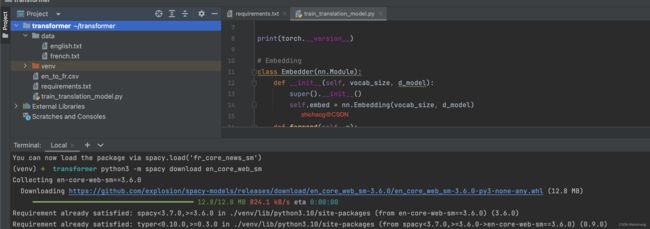大语言模型之一 Attention is all you need ---Transformer
大语言模型已经在很多领域大显身手,其应用包括只能写作、音乐创作、知识问答、聊天、客服、广告文案、论文、新闻、小说创作、润色、会议/文章摘要等等领域。在商业上模型即产品、服务即产品、插件即产品,任何形态的用户可触及的都可以是产品,商业付费一般都是会员制或者按次收费。当前大预言模型的核心结构是基于Transformer。
大模型之所以效果超出预期,一个很重要的原因是模型大到一定程度之后会发生质变,模型的记忆性和泛化性可以兼得。而Transformer可以令模型很大,大到在NLP领域模型可以发生质变,这使得应用得以井喷式出现在各个领域,但是也有一些问题存在需要进一步解决,这类大模型本质上是内容生成,生成的内容因符合如下三原则:
有用的(Helpful);
可信的(Honest);
无害的(Harmless)
仅仅基于Transformer框架的大预言模型(又称pretraining model)还不足以完全满足商业应用要求,业界的发展放到后续博客展开,本篇先谈谈大语言模型的核心架构Transformer。
Transformer 源于谷歌Brain 2017年针对机器翻译任务提出的,《Attention is all you need》论文详细解释了网络结构,在这个之前网络结构多采用RNN、CNN、LSTM、GRU等网络形式,这篇文章提出了一个新的核心结构-Transformer,其针对RNN网络在机器翻译上的弱点重新设计的结构,传统的Encoder-Decoder架构在建模过程中,下一个时刻的计算过程会依赖于上一个时刻的输出,而这种固有的属性就限制了传统的Encoder-Decoder模型就不能以并行的方式进行计算。
本文源码已托管到 github link地址
模型结构介绍
谷歌提出的Transformer也是包括Encoder和decoder两个部分,只是这两个部分核心是Attention结构,而非CNN、LSTM、GRU等这些结构。
对于Encoder,包含两层,一个self-attention层和一个前馈神经网络,self-attention能帮助当前节点不仅仅只关注当前的词,从而能获取到上下文的语义。Decoder也包含encoder提到的两层网络,但是在这两层中间还有一层attention层,帮助当前节点获取到当前需要关注的重点内容。

Transformer 模型架构
模型需要对输入的数据进行一个embedding操作(图中红色框框),Attention虽然可以提取出关注的信息,但是没有时序信息,而Position Encoding正是将时序信息转为位置信息来实现的,enmbedding结束之后加上位置编码,然后再输入到encoder层,self-attention处理完数据后把数据送给前馈神经网络(蓝色Feed Forward),前馈神经网络的计算可以并行,得到的输出会输入到下一个encoder。

- Encoder 编码器
- Multi-Head Attention
- 多头自注意力机制,可以通过输入信息并行计算出查询-键-值(Query-Key-Value),来让后续的网络使用context来知道当前运算需要关注哪些信息。注意这里的计算QKV的矩阵也是网络参数的一部分,通过训练可以让网络的注意力更有效且集中。因为NLP领域都是时序上因果的,因而改进模型采用了因果多头自注意力模型。
- Add 残差连接
- 这里主要残差连接的主要作用是利用恒等映射来训练更深层的网络(输入和输出恒等),多头注意力和层归一化,前馈神经网络和层归一化,两部分均采用了残差连接。
- Norm 层归一化
- Layer Normalization 的作用是把神经网络中以样本维度为一层来进行归一化运算,以起到加快训练速度,加速收敛的作用。新的改进都是将Layer Normalization放在前面而非后面。
- Feed Forward 前馈神经网络
- 将通过了注意力层之后通过加权机制提取出的所关注信息,根据关注的信息在语义空间中做转换。
- 因此MLP将Multi-Head Attention得到的向量再投影到一个更大的空间(论文里将空间放大了4倍)在那个大空间里可以更方便地提取需要的信息(使用Relu激活函数),最后再投影回token向量原来的空间。
- Multi-Head Attention
- Decoder
- 和 Encoder基本一样,组成分为Masked Multi-Head Attention,Masked Encoder-Decoder Attention(这一层就是连接编码器和解码器的注意力层,后续由于GPT只用了编码器,因此删除了这一层。)和Feed Forward神经网络,三个部分的每一个部分,都有一个残差连接,后接一个Layer Normalization。下面介绍Decoder的Masked Self-Attention和Encoder-Decoder Attention两部分,
- Masked Multi-Head Attention
- Self-Attention的机制有一个问题,在训练过程中的完整标注数据都会暴露在 Decoder 中,这显然是不对的,我们需要对 Decoder 的输入进行一些处理,该处理被称为 Mask,将数据有选择的暴露给Decoder(在GPT中相当于遮住了后面的所有数据,由网络依次生成)。
- Multi-Head Attention
- Add 残差连接
- Norm 层归一化
- Feed Forward 前馈神经网络
- 线性层和Softmax
经过编码器和解码器最后是一层全连接层和SoftMax( 后面改进的大语言模型采用Gaussian Error Linear Units function)。线性层是一个简单的全连接的神经网络,它将解码器堆栈生成的向量投影到一个更大的向量,称为logits向量。Softmax层(Softmax 是用于多类分类问题的激活函数)将向量转换为概率(全部为正值,总和为1.0)。选择概率最高的单元,并生成与其关联的单词作为此时间步的输出。
模型Pytorch实现
红色部分input&output embedding。
class Embedder(nn.Module):
def __init__(self, vocab_size, d_model):
super().__init__()
self.embed = nn.Embedding(vocab_size, d_model)
def forward(self, x):
#[123, 0, 23, 5] -> [[..512..], [...512...], ...]
return self.embed(x)
位置编码
如下代码所示,其值会和上面的embedding相加后输入编解码模块。
class PositionalEncoder(nn.Module):
def __init__(self, d_model: int, max_seq_len: int = 80):
super().__init__()
self.d_model = d_model
#Create constant positional encoding matrix
pos_matrix = torch.zeros(max_seq_len, d_model)
# for pos in range(max_seq_len):
# for i in range(0, d_model, 2):
# pe_matrix[pos, i] = math.sin(pos/1000**(2*i/d_model))
# pe_matrix[pos, i+1] = math.cos(pos/1000**(2*i/d_model))
#
# pos_matrix = pe_matrix.unsqueeze(0) # Add one dimension for batch size
den = torch.exp(-torch.arange(0, d_model, 2) * math.log(1000) / d_model)
pos = torch.arange(0, max_seq_len).reshape(max_seq_len, 1)
pos_matrix[:, 1::2] = torch.cos(pos * den)
pos_matrix[:, 0::2] = torch.sin(pos * den)
pos_matrix = pos_matrix.unsqueeze(0)
self.register_buffer('pe', pos_matrix) #Register as persistent buffer
def forward(self, x):
# x is a sentence after embedding with dim (batch, number of words, vector dimension)
seq_len = x.size()[1]
x = x + self.pe[:, :seq_len]
return x
self-attention
## Scaled Dot-Product Attention layer
def scaled_dot_product_attention(q, k, v, mask=None, dropout=None):
# Shape of q and k are the same, both are (batch_size, seq_len, d_k)
# Shape of v is (batch_size, seq_len, d_v)
attention_scores = torch.matmul(q, k.transpose(-2, -1)) / math.sqrt(q.shape[-1]) # size (bath_size, seq_len, d_k)
# Apply mask to scores
#
if mask is not None:
attention_scores = attention_scores.masked_fill(mask == 0, value=-1e9)
# Softmax along the last dimension
attention_weights = F.softmax(attention_scores, dim=-1)
if dropout is not None:
attention_weights = dropout(attention_weights)
output = torch.matmul(attention_weights, v)
return output
Multi-Head Attention layer
# Multi-Head Attention layer
class MultiHeadAttention(nn.Module):
def __init__(self, n_heads, d_model, dropout=0.1):
super().__init__()
self.n_heads = n_heads
self.d_model = d_model
self.d_k = self.d_v = d_model // n_heads
# self attention linear layers
#Linear layers for q, k, v vectors generation in different heads
self.q_linear_layers = []
self.k_linear_layers = []
self.v_linear_layers = []
for i in range(n_heads):
self.q_linear_layers.append(nn.Linear(d_model, self.d_k))
self.k_linear_layers.append(nn.Linear(d_model, self.d_k))
self.v_linear_layers.append(nn.Linear(d_model, self.d_v))
self.dropout = nn.Dropout(dropout)
self.out = nn.Linear(n_heads*self.d_v, d_model)
def forward(self, q, k, v, mask=None):
multi_head_attention_outputs = []
for q_linear, k_linear, v_linear in zip(self.q_linear_layers,
self.k_linear_layers,
self.v_linear_layers):
new_q = q_linear(q) # size: (batch_size, seq_len, d_k)
new_k = q_linear(k) # size: (batch_size, seq_len, d_k)
new_v = q_linear(v) # size: (batch_size, seq_len, d_v)
# Scaled Dot-Product attention
head_v = scaled_dot_product_attention(new_q, new_k, new_v, mask, self.dropout) # (batch_size, seq_len,
multi_head_attention_outputs.append(head_v)
# Concat
# import pdb; pdb.set_trace()
concat = torch.cat(multi_head_attention_outputs, -1) # (batch_size, seq_len, n_heads*d_v)
# Linear layer to recover to original shap
output = self.out(concat) # (batch_size, seq_len, d_model)
return output
翻译实例
这里github链接
以英语到法语的翻译实例展示Transformer这篇文章所述网络模型结构和其用法。Python安装版本信息如下:
Python 3.7.16
torch==2.0.1
torchdata==0.6.1
torchtext==0.15.2
spacy==3.6.0
numpy==1.25.2
pandas
times
portalocker==2.7.0
数据处理
分词和词映射为张量化的数字
使用torchtext提供的工具比较方便创建一个便于处理迭代的语音翻译模型的数据集,首先是从原始文本分词、构建词汇表以及标记为数字化张量。尽管torchtext提供了基本的英语分词支持,但是这里的翻译中除了英语还有法语,因而使用了分词python库Spacy。
首先是创建环境,接下来是下载英语和法语的分词器,因为这是一个很小的例子,因而使用新闻的spacy语言处理模型即可:
#python3 -m spacy download en_core_web_sm
#python3 -m spacy download fr_core_news_sm
接下来是将数据进行分词,然后将词映射为张量化的数字
#Data processing
import spacy
from torchtext.data.utils import get_tokenizer
from collections import Counter
import io
from torchtext.vocab import vocab
src_data_path = 'data/english.txt'
trg_data_path = 'data/french.txt'
en_tokenizer = get_tokenizer('spacy', language='en_core_web_sm')
fr_tokenizer = get_tokenizer('spacy', language='fr_core_news_sm')
def build_vocab(filepath, tokenizer):
counter = Counter()
with io.open(filepath, encoding="utf8") as f:
for string_ in f:
counter.update(tokenizer(string_))
return vocab(counter, specials=['' , '' , '' , '' ])
en_vocab = build_vocab(src_data_path, en_tokenizer)
fr_vocab = build_vocab(trg_data_path, fr_tokenizer)
def data_process(src_path, trg_path):
raw_en_iter = iter(io.open(src_path, encoding="utf8"))
raw_fr_iter = iter(io.open(trg_path, encoding="utf8"))
data = []
for (raw_en, raw_fr) in zip (raw_en_iter, raw_fr_iter):
en_tensor_ = torch.tensor([en_vocab[token] for token in en_tokenizer(raw_en)], dtype=torch.long)
fr_tensor_ = torch.tensor([fr_vocab[token] for token in fr_tokenizer(raw_fr)], dtype= torch.long)
data.append((en_tensor_, fr_tensor_))
return data
train_data = data_process(src_data_path, trg_data_path)
DataLoader
DataLoader是torch.utils.data提供的方法,其将数据集和采样器组合在一起,为给定的数据集提供可迭代的对象。DataLoader 支持单进程或多进程加载、自定义加载顺序和可选的自动批处理(合并)和内存固定的映射式和可迭代式数据集。
collate_fn(可选),它将样本列表合并以形成张量的小批量。在使用映射样式数据集的批量加载时使用。
#Train transformer
d_model= 512
n_heads = 8
N = 6
src_vocab_size = len(en_vocab.vocab)
trg_vocab_size = len(fr_vocab.vocab)
BATH_SIZE = 32
PAD_IDX = en_vocab['']
BOS_IDX = en_vocab['']
EOS_IDX = en_vocab['']
from torch.nn.utils.rnn import pad_sequence
from torch.utils.data import DataLoader
def generate_batch(data_batch):
en_batch, fr_batch = [], []
for (en_item, fr_item) in data_batch:
en_batch.append(torch.cat([torch.tensor([BOS_IDX]), en_item, torch.tensor([EOS_IDX])], dim=0))
fr_batch.append(torch.cat([torch.tensor([BOS_IDX]), fr_item, torch.tensor([EOS_IDX])], dim=0))
en_batch = pad_sequence(en_batch, padding_value=PAD_IDX)
fr_batch = pad_sequence(fr_batch, padding_value=PAD_IDX)
return en_batch, fr_batch
train_iter = DataLoader(train_data, batch_size=BATH_SIZE, shuffle=True, collate_fn=generate_batch)



